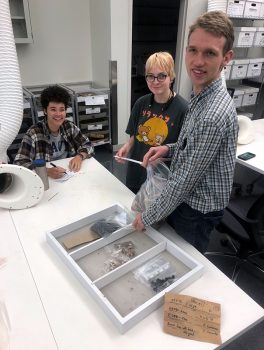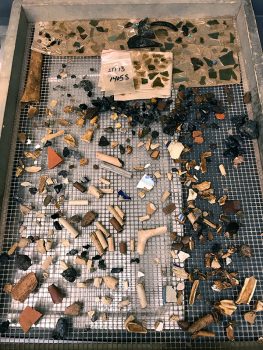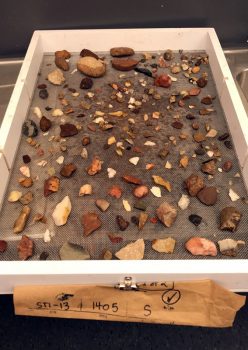Back to Dispatches from Field School
Field School 2018 – Week 3
Shaelyn Harris — Loyola University Maryland
“Into the Laboratory”

Field school students (from left) Shaelyn Harris, Jade Arnold, and James Hensley hard at work in the lab.
This week I traded in my trowel and screen for a toothbrush and sink as I began a week of work in HSMC’s archaeology laboratory. As part of this season’s first lab rotation, myself and two other students would be taking a look at exactly what happens after our finds exit the site and enter the lab. Although we had previously had a quick glimpse at the archaeology labs and archives on our tour during our first week, this upcoming week would give us a much deeper look into many of the resources and techniques used in processing the artifacts.
The major goal of the lab is to preserve the artifacts and their cultural significance while organizing them into a larger set of data for further analysis. In other words, by properly conserving these objects, we can create a more developed picture of the larger context from which they came, thereby gaining a greater understanding of life in the Maryland colony at specific moments in time. How these artifacts are able to do just this became clearer and clearer as the week went on.
We began by first reviewing some fundamental concepts, one of the most important being “provenience.” This refers to the position of an archaeological find in time and space, which in our case refers to the site, unit, and layer of soil it was found in. To create an accurate illustration of an early St. Mary’s City, the provenience of each artifact needed to be preserved. And luckily for us, this was made simple by the labels used in the field which documented all this information and more.
Following our intro, we jumped right into things and began cleaning some artifacts that had been saved from the previous summer’s Field School. This involved sorting the various artifacts from the field bags, washing and drying them, and re-bagging them. The artifact’s material determined how it was cleaned; bricks, ceramics, rocks, shells, tobacco pipe shards, and bone were wet washed using a toothbrush and water, while plaster and metal artifacts (nails, lead musket balls, etc.) were dry brushed. Glass artifacts were wet brushed using a deionized solution. And not unlike work out on the site, we used metal screens. Although, rather than using them to sift through excavated soil they served as drying racks for our freshly cleaned finds.
Despite the tedious nature of the work it was great to get a much closer look at the artifacts, especially the ceramics (which we will soon be quizzed on in our upcoming midterm). It was exciting to follow some of the artifacts (which we had found the previous week) from the specific unit at our excavation site through the lab process. After being cleaned, these artifacts were to be individually labeled and logged into a database. From there they will find a new home among the thousands of other artifacts living in the extensive archive of Historic St. Mary’s City. While each individual piece may not seem to provide much significance on its own, within the larger context into which it is placed we begin to find a much more elaborate picture of daily life in the colony.



